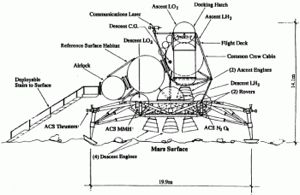
Home - Search - Browse - Alphabetic Index: 0- 1- 2- 3- 4- 5- 6- 7- 8- 9
A- B- C- D- E- F- G- H- I- J- K- L- M- N- O- P- Q- R- S- T- U- V- W- X- Y- Z
STCAEM MEV
 STCAEM MEV Credit: NASA |
Status: Study 1991.
It consisted of a surface-stay habitat module (roughly Space Station Freedom-module size), an airlock, 5 metric tons of surface-science payload, a cryogenic ascent propulsion system with four engines and bus structure, and the ascent vehicle (MAV).
The MAV ascent vehicle consisted of a short-duration crew cab and a cryogenic ascent propulsion system with two engines. All propellant tanks were mass-balanced around their maneuver CMs so that no lateral CM shifting occurs. The entire MEV was packaged in a rigid, truncated-hyperboloidal aerobrake with L/D = 0.5, to which it was attached at eight points (four bus-frame corners and four landing-gear footpads). The aerobrake was fitted with doors, which opened to allow the descent engines to extend and ignite prior to aerobrake separation (allowing full benefit of the brake's drag). The brake was then jettisoned as the landing gear extends prior to terminal approach and hovering touchdown.
Dominant configuration constraints for the MEV were as follows:
- Payload manifesting
- Surface access
- Contiguous crew volumes
- Short vehicle stack
- Engine-out capabilities
- On-orbit assembly
The MEV for the cryogenic/aerobrake mission had a total mass of 84,349 kg with the breakdown was as follows:
- Mars capture and descent aerobrake, 15,138 kg
- MEV Ascent stage, 22,754 kg
- MEV Descent stage, 21,457 kg
- Surface cargo, 25,000 kg
The MEV for the NTR, NEP, and SEP missions (no aerobraking into Mars orbit required) had a total mass of 73,118 kg with the breakdown was as follows:
- Mars descent aerobrake, 7,000 kg
- MEV Ascent stage, 22,464 kg
- MEV Descent stage, 18,659 kg
- Surface cargo, 25,000 kg
Family: Mars lander. Country: USA. Spacecraft: STCAEM Cryogenic Aerobrake, STCAEM NEP, STCAEM SEP, STCAEM NTR. Agency: NASA, Boeing. Bibliography: 1985.
Back to top of page
Home - Search - Browse - Alphabetic Index: 0- 1- 2- 3- 4- 5- 6- 7- 8- 9
A- B- C- D- E- F- G- H- I- J- K- L- M- N- O- P- Q- R- S- T- U- V- W- X- Y- Z
© 1997-2019 Mark Wade - Contact
© / Conditions for Use